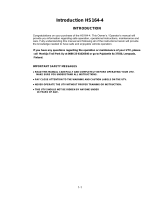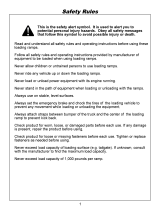
3Section 2 — important Safe operation practiceS
30. Do not touch engine or exhaust
components while engine is running or
soon after it is stopped. They will be hot
and can cause a burn.
31. Always inspect your vehicle each time
you use it to make sure it is in safe
operating condition. Always follow the
inspection and maintenance procedures
and schedules described in this manual.
32. Do not use the differential lock when
driving down hill. Do not use the
differential lock at speeds over 25
mph. Allow for greater turning radius
and more difficult steering when the
differential lock is engaged.
33. If situations occur which are not covered
in this manual, use care and good
judgement. Contact your local service
center or call toll free 1-877-282-8684 for
the name of your nearest service center.
Occupant Size and Capacity
1. Make sure operators are at least 16 years
old and have a valid driver’s license.
2. Each occupant should be able to sit with
their back against the seat, feet flat on
the floor, and hands on the steering
wheel or handholds.
3. The operator should be tall enough to wear
the seat belt properly and reach all controls.
4. Passengers should also be tall enough for
the seat belt to fit properly and be able
to brace themselves, as necessary, by
placing both feet firmly on the floor while
gripping the handholds. Keep all body
parts completely inside the vehicle.
Dress Properly
1. Proper clothing can reduce the severity
of injury in the event of an accident.
2. Always wear appropriate eye protection
and protective clothing. It is also
recommended that you wear a properly
fitting D.O.T. approved helmet.
Slope Operation
Slopes are a major factor related to loss of
control and rollover accidents, which can result
in severe injury or death. If a slope is steeper
than a 15 degree incline, do not operate this
vehicle on that area. Exercise extreme caution
while operating on slopes.
Do:
1. Travel straight up and down slopes, not
across. Exercise extreme caution when
changing direction on slopes.
2. Travel slowly while on a slope. Always
keep the forward speed limited when
going down slopes to take advantage of
the engine braking action.
3. Keep all movement on the slopes slow
and gradual. Avoid starting or stopping
on a slope.
4. Avoid slopes with slippery, loose, or bumpy
surfaces as they are especially hazardous.
5. Use extra care while carrying cargo. It
may affect the stability of the vehicle.
Spread the load evenly and tie down.
Do Not:
1. Do not travel near drop-offs, ditches
or embankments. The vehicle could
suddenly turn over if a wheel is over the
edge of a cliff, ditch, or if an edge caves in.
2. Do not stop or start suddenly when going
uphill or downhill. Be especially cautious
when changing direction on slopes.
3. Do not turn sideways to the hill. The
vehicle may roll over. If you must turn, go
slow and do so carefully and gradually.
4. Do not carry cargo or tow loads on steep
slopes.
Towing
1. Always use an approved hitch and hitch
point provided on the utility vehicle.
2. Do not tow more than 1200 lbs. (544 kg)
rolling weight (i.e. trailer plus cargo).
3. Never load more than 110 lbs. (50 kg)
tongue weight on tow bracket provided.
4. Go slow and use extra care when towing
a trailer. Allow for increased braking
distance. Load trailer properly.
5. Do not tow heavy loads on slopes
greater than 5 degree incline. When
going downhill or turning, the extra
weight tends to push the tow vehicle
and may cause you to loose control (i.e.
braking and steering ability are reduced,
towed equipment may jack-knife and
cause utility vehicle to overturn).
Cargo Box Loading/Operation
1. Do not exceed vehicle’s Total Load
Capacity rating of 1000 lbs. (453.5 kg)
This includes operator, passenger,
accessories, and cargo.
2. Do not exceed 500 lbs. (226.7 kg) load in
cargo box.
3. Spread load evenly and secure to
prevent movement.
4. Do not load above height of cargo box
front panel. Load could shift forward and
injure driver or passenger.
5. Avoid loads which exceed the physical
dimensions of cargo box.
6. Go slow. Heavy loads will affect steering,
braking, stability, and overall handling of
the vehicle. Limit loads to those that can
be safely controlled.
7. Avoid sudden starts, stops, and turns
which could cause load to shift.
Cargo Box Lift
1. Stop vehicle on level ground, move
the shift lever into the “PARK” position
before raising cargo box.
2. On manual lift units, unload cargo box
before raising cargo box.
3. Do not operate vehicle with cargo box in
raised position.
4. Do not operate vehicle with cargo box
latch unlatched. Always re-latch upon
manually lowering cargo box.
When using optional electric lift:
a. Stay in driver’s seat.
b. Keep body parts away from cargo
box and keep all bystanders
away.
c. Do not allow rear wheels to hang
over the edge of a drop-off when
raising cargo box. The load in the
cargo box may shift causing the
vehicle to tip over backwards.
Safety Frame (OPS)
1. Your vehicle is equipped with a
occupant protection structure (OPS)
which must be maintained in a fully
functional condition. Use care when
driving through doorways or spaces
with a low overhead.
a. Never modify the OPS in any way.
b. Never attempt to straighten
or reweld any part of the main
frame or retaining brackets that
have been damaged. Doing so
may weaken the structure and
endanger your safety.
c. Never secure any parts other
than Cub Cadet approved
accessories on the main frame
or attach the safety frame with
anything other than the special
fasteners specified.
d. Never attach ropes, chains, or
cables to the OPS for pulling
purposes.
e. Although the OPS, when used
with a properly secured seat
belt, provides a crush-protective
environment in the event of a
tip-over or rollover, never take
unnecessary risks.
Children
1. Tragic accidents can occur if the
operator is not alert to the presence of
children. Children are often attracted to
the vehicle. They do not understand the
dangers. Never assume that children will
remain where you last saw them. Avoid
run over accidents.
a. Keep children out of the
immediate area of the vehicle
and in watchful care of a
responsible adult other than the
operator.
b. Be alert and turn the vehicle off if
a child enters the area.
c. Before and while backing, look
behind and down for small
children.
d. Never carry small children, they
may fall off and be seriously
injured or interfere with safe
vehicle operation.
e. Use extreme care while
approaching blind corners,
doorways, shrubs, trees or other
objects that may block your
vision of a child who may run into
the path of the vehicle.
f. Remove key when vehicle
is unattended to prevent
unauthorized operation.
2. Never allow children under 16 years old
to operate this vehicle. Children 16 years
old and over should read and understand
the operation instructions and safety
rules in this manual and should be trained
and supervised by a parent.
3. Do not let children ride in the cargo
box, in the driver’s or passenger’s lap
or anywhere other than the passenger
seat. Never give small children a ride; not
even in the passenger seat. They may
fall off.
Service
Safe Handling Of Fuel:
1. To avoid personal injury or property
damage use extreme care in handling
fuel. Fuel is extremely flammable and the
vapors are explosive. Serious personal
injury can occur when fuel is spilled on
yourself or your clothes which can ignite.
Wash your skin and change clothes
immediately.























